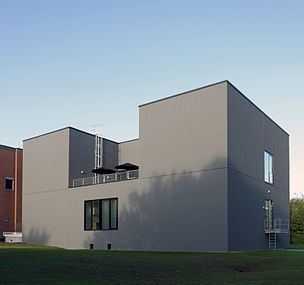Abbreviation ER-C Successor n/a Type Research Laboratory Staff 40 | Predecessor none Established 27 January 2004 Founded 27 January 2004 Motto Physics is our Profession | |
 | ||
Location Jülich, Prussia, Germany | ||
The Ernst Ruska-Centre (ER-C) for Microscopy and Spectroscopy with Electrons is a German research establishment conjointly operated by the Jülich Research Centre and RWTH Aachen University on a pari passu basis. The facility, which also offers user services to external research groups, is located on the campus of Research Centre Jülich belonging to the Helmholtz Association of German Research Centres.
The ER-C's main purposes are fundamental research in high-resolution transmission electron microscopy method development as well as respective applications coming along with topical problems in solid state research and energy research. For theses purposes the ER-C runs several state-of-the-art transmission electron microscopes and develops customed software solutions to be used for e.g. for the exit wave retrieval purposes or the measurement of higher-order lens aberrations.
The ER-C was founded in Aachen on 27 January 2004 by means of a contract signed by the chairman of Forschungszentrum Jülich Joachim Treusch and RWTH Aachen University's rector Burkhard Rauhut. The centre was inaugurated on 18 May 2006 in presence of members of the Ernst Ruska family as well as representatives of the international electron microscopy community.
Research Programmes
Focal points of inherent ER-C research programmes cover the scrutineering of, both, the theoretical and the applied aspects of high-resolution transmission electron microscopy, which in turn represents the most important analysis methods at the centre. Numerical software packages largely developed by ER-C scientists and allowing for the retrieval of the exit plane wavefunction together with the precise control of higher order lens aberrations are in use globally in a continuously increasing number of electron microscopy laboratories.
Present in-house materials science research projects focus on the investigation of the epitaxial growth mechanisms and the relaxation behaviour of nanostructured material combinations by software-based methods of transmission electron microscopy. Relevant research projects comprise high-precision measurements of atomic spacings down to a few picometres, the identification of novel relaxation mechanisms together with the quantification of individual contributions towards the reduction of elastic stresses in lattice strained heterostructures, the quantification of interdiffusion related parameters in multilayer systems on the atomic scale as well as the measurement of dopant induced electrical fields by means of electron holography techniques. Material classes investigated include nanostructured electroceramics, complex metallic alloys, semiconductor materials and oxide superconductors together with lattice defects by advanced techniques electron microscopy.
